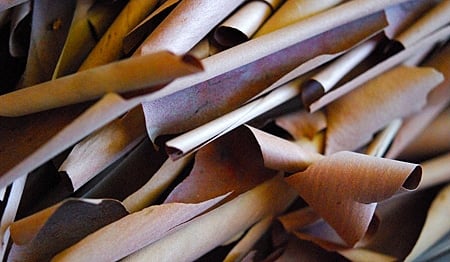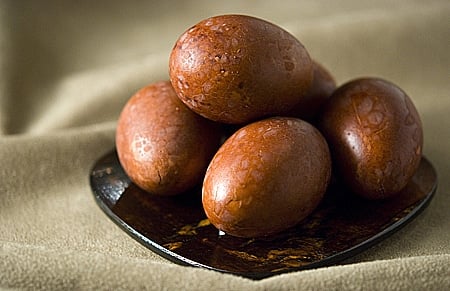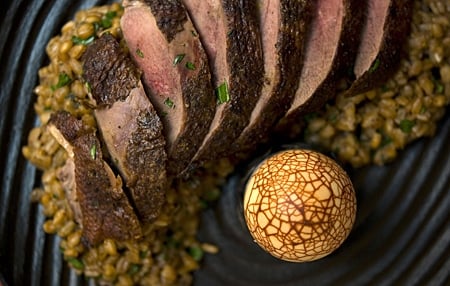Experiments with Madrone Bark Tea
October 18, 2009 | Updated October 27, 2020
As an Amazon Associate I earn from qualifying purchases.

Not much about cooking excites me more than experimenting with a new ingredient. I get especially jazzed when that ingredient is not only new to me, but new to the rest of the culinary world as well. It’s a rush, that feeling — real or imagined — that I am adding something new to our collective knowledge of food, rather than rehashing the genius of those who went before me.
Madrone bark has been one of the best of these experiences.
What is it? Madrone, or madrona, is a tree that is native to California’s Central Coast and Sierra Foothills. It is a long-lived, evergreen cousin of manzanita, and its bark bursts into cinnamon-like curls every summer. The Indians who first lived here gathered madrone bark to make a tea they used topically to treat sores, and internally to cure a sore throat.
The taste of madrone bark tea is like a combination of cinnamon, mushrooms, wood, tannin and something else I find hard to pinpoint; a zephyr of fruitiness is the best I can come up with.
Almost no one now uses madrone bark. I know of only a few other cooks working with it, notably Ron Zimmerman of the Herbfarm restaurant outside Seattle; Zimmerman is, more than any other chef I know, a man after my own heart.
His work focuses on creative use of plants, both wild and domestic, and he posseses the creativity of a Grant Achatz without leaving the soil that surrounds his restaurant. Zimmerman uses madrone bark tea to flavor risotto and as an ingredient in ice cream. He probably has other uses, but those are what I am aware of.
Fortunately Holly’s mother Ruth has a mature madrone tree in her yard in Nevada County, so I have a ready supply to play with. What I quickly learned is that the trick with madrone is to highlight its subtle flavor without knocking your guests over with woody tannins.
Madrone bark tea gets dark in a hurry, too. With a concentration of about 20 bark curls to 2 quarts of water, the tea rapidly turns a rich red mahogany, a little like South African red tea. With that in mind, I thought it might be fun to make my first-ever Chinese tea egg with not with tea, but with madrone.

What’s a tea egg? It’s a cool Chinese snack. You boil eggs, then crack the shells all over, then simmer the eggs for several hours in a combination of tea, soy sauce, star anise and lemon rind. I wanted to do a Western interpretation of the eggs with madrone, so I used the bark tea, bay leaves, a star anise, lemon rind, juniper berries and salt.
I also used duck eggs, given to me by my friend Josh, who has a trio of ducks wandering around his back yard. This turned out to be a mistake, because duck eggs, I later realized, have a much thicker inner membrane than chicken eggs — meaning that cracking the shell doesn’t also break that membrane. Flavor still seeps in, so the eggs tasted great, but “The Reveal” in a tea egg is that beautiful latticework design on the egg itself; it looks like a spiderweb.
I cheated on these eggs, picking off the shell but leaving the membrane on for the photo. If you use a chicken egg it should look like the picture. Aren’t they gorgeous? And they taste warm and deep, rich, slightly tannic — this is a hard-boiled egg you want to linger over.
There was a reason I wanted to use duck eggs for this recipe. I knew you can reuse the madrone bark tea infusion you cook the eggs in, so I added another two tablespoons of salt and used it to brine one of the mallards I’d shot in Canada. Now normally I don’t brine my ducks, but these Canadian ducks had very little fat on them (my friend Kevin Kossowan laments this often; he lives near Calgary), so I needed to add as much moisture as I could.
I wanted to serve them both on the same plate, so it’d be duck eggs with duck meat. And just to push Iron Chef Madrone & Duck even further, I decided to tie everything together with a farrotto — farro, a primitive wheat related to spelt, cooked like a risotto — made with morel mushrooms, shallots, madrone bark tea and duck fat. Click here for the full farrotto recipe.

This dish is concentrated wild. It feels, smells and tastes like the deepest woods — almost murky. Only a last-minute squirt of lemon juice allowed some light to shine through a canopy of dark, warm flavors that feels like a flannel comforter in a snowstorm. This is an awesome dish for a cold evening.
As good as it was, I’m not done with my madrone experiments. I want to concentrate the flavor more next time — bring it right to the edge of the tannic wall that would make it inedible — and see what I can do with it then.
Other possibilities abound. Maybe grind it to a powder and use it as a flavoring in sausage or salami? Grind it with coarse salt to make a finishing salt for venison or beef? And what about sweet dishes, like Zimmerman’s ice cream? Madrone sugar, anyone?
I can’t wait to play with this some more, but I’m wondering if I am alone out there. Have any of you ever worked with madrone? What about other tree barks?
Madrone Bark Tea Eggs
Ingredients
- 1 dozen eggs
- 6 cups madrone tea, (see below)
- 2 bay leaves
- 1 star anise
- zest of a lemon
- 10 crushed juniper berries
- 3 tablespoons kosher salt
Instructions
- To make the madrone bark tea, bring 6-7 cups of water to a boil, then add 15-25 madrone bark curls. Cover and turn off the heat. Let steep overnight. This tea lasts a long time in the fridge, so you can make it ahead of time.
- Boil the eggs in plain water to start. Put the eggs in a pot, cover with cool water and bring to a boil. Turn the heat down and simmer for 2-3 minutes, then turn off the heat. When the water is cool enough to touch, pull the eggs out and submerge in cold water.
- Meanwhile add all the remaining ingredients into a large pot and bring to a simmer.
- Take each egg and crack the shell gently all around the egg. You want it to stay intact, but be covered in tiny cracks.
- Place the eggs in the madrone tea and simmer for 2-3 hours. Turn off the heat, cover and steep overnight. Eat cold or at room temperature.
Nutrition information is automatically calculated, so should only be used as an approximation.






This sounds great, I told my uncle about it and he suggested my mom could try it with sour sop leaves, which makes a reddish colored tea. By the way, can you tell me where I can get that swirly metal egg holder??
Beautiful! We have lots of Madrone on our property in Trinity Co. Great info.
Becky: Thanks! You will need to wait to get the best madrone bark — it is best collected in high summer. Ron may have some, and in a pinch I can mail you some.
As for its edibility, there is a lot if information about how Native Americans used it, and when I dug deeper there has been some scientific work done on its nutritional properties. That was enough for me, and I then began thinking how would this stuff a) taste, and b) be used.
I am still not done with experiments, but I am thinking of pulverizing it and adding it to a dry rub and also using it as a smoking additive. I am sure other uses will spring to mind, too.
What are you thinking about with using it?
Hank: Beautiful work! Can’t wait to play with Madrone bark. My question is always: How did you and/or Ron figure out it was edible to begin with? Was the info on how the Native Americans used it enough for you or did you try it, wait 24 hours and decide it was fit for human consumption?
Hank, you devil, well done! I’m stealing the Madrone Eggs for my Christmas Dinner. Going to microscopically saw ’em in half and replace the yolks with a Madrone-Smoked Salmon Mousse Yolk and present the whole affair in an egg cup on the back of yellow ceramic chicks.
Rich: Herbfarm is where I heard about using madrone bark tea. Sorry, I don’t know any commercial suppliers of the stuff.
I had madrona bark tea at the Herbfarm last summer. It was great. As I remember, they said that there is one commercial supplier of madrona bark. Do you know who it is?
The eggs… look beautiful. They look like almost porcelain – as if they have been painted on. Great job!
No worries, but I do hear the wood makes for good BBQ. What I was more thinking was use the bark like you would tea in a tea-smoked recipe similar to this one https://splendidtable.publicradio.org/recipes/fish_scallops.html I imagine either you’d get a sublime smoke/cinnamon thing or it would turn acrid when burned. Donno. My parents have some madronas on their land, I’ll see if I can get some bark and try it. Frankly I may just walk down to the park today and grab some…
Carolina Rig and Scott: I like the idea of a rub using the ground bark. Will have to see how fine I can grind it.
Russell: I don’t use the wood, just the fine bark, so no splitting needed…
Stunning work on the eggs!
You and Herbguy are going deep… My own culinary experiments with madrone involve not the bark but the mycorrizhal action popping up around the roots–edible Amanita mushrooms known to Italians as Coccoli (“coddled babies”), and by the various Latin names Amanita calyptrata & Amanita lanei. These mushrooms are found in the Pacific Northwest in the company of madrone, but I wouldn’t go eating one unless you know exactly what’s what; a mistake might be deadly.
Keep up the adventurous work!
What about using soaked madrona for cold smoking something (or heck, hot smoking if it doesn’t destroy the flavor)?
Wow, great egg. We get Madrone (I always called it Madrona) up here in Seattle too (hence the Herbfarm). I’ve been thinking about using it for smoking things, say maybe a quick pan smoke of scallops with the bark like you might with tea, or curing some wood and doing a pork shoulder. Let you know if I end up doing it. Word on the vine is the wood gets very hard once it’s dry, so split it green.
Farrotto, nice! Hank, I’m all for grinding it up for salumi purposes. But, if you just want to get a feel for it, try it ground up and used in a dry rub.
Madrone bark tea eggs? Looks like a stroke of genius to me. 🙂
As for other madrone bark experiments… I’d be tempted to try it in an orange spice cake in place of cinnamon.
WOW! Its almost too pretty to eat.
I’ve had some killer feral pig ribs using black tea in the rub. I wonder how madrone would fair in a rub?
Those eggs are so beautiful! Good for you with such a fun experiment. I look forward to reading about more adventures with madrone.
Those eggs look pretty.
I didn’t get up to the madrone I’d told you about this weekend, maybe later in the week…
Man, I so want to try that dish, or at the least the eggs, or at the VERY least the tea itself. =)